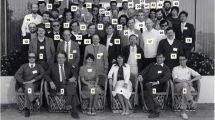Abstract
Historically, very long baseline interferometry became possible by the invention of atomic frequency standards more than 40 years ago. Since then, the reliable spatial reference frame has been constructed from numerous space geodetic observations and the construction of international atomic time is now relying on the spatial reference frame and space geodetic observations. The time and frequency difference between two places separated by a long distance can be precisely measured by using very long baseline interferometry, and therefore this technique is expected to have a potential to be used to compare and evaluate optical frequency standards. This paper tries to review the principle of the very long baseline interferometry and its use for time and frequency metrology.


Similar content being viewed by others
References
F. Takahashi, T. Kondo, Y. Takahashi and Y. Koyama, Very Long Baseline Interferometer, Ohmsha, Ltd. and IOS Press, Tokyo (2000).
T.A. Clark, B.E. Corey, J.L. Davis, G. Elgered, T.A. Herring, H.F. Hinteregger, C.A. Knight, J.I. Levine, G. Lundqvist, C. Ma, E.F. Nesman, R.B. Phillips, A.E.E. Rogers, B.O. Rönnäng, J.W. Ryan, B.R. Schupler, D.B. Shaffer, I.I. Shapiro, N.R. Vandenberg, J.C. Webber and A.R. Whitney, Precision Geodesy Using the Mark-III Very Long Baseline Interferometer System, IEEE Trans. Geosci. Remote Sens., GE-23 (1985) 438-449.
T. Hobiger, Y. Kinoshita, S. Shimizu, R. Ichikawa, M. Furuya, T. Kondo and Y. Koyama, On the Importance of Accurately Ray-Traced Troposphere Corrections for Interferometric SAR Data, J. Geodesy, 84(9) (2010) 537-546.
C. Boucher and Z. Altamimi, The Initial IERS Terrestrial Reference Frame, IERS Technical Note No. 1 (1989).
W.R. Dick and B. Richter (eds.), IERS Annual Report 2007, International Earth Rotation and Reference Systems Service, Central Bureau, (2009). ISBN:978-3-89888-917-9.
Z. Altamimi, X. Collilieux, J. Legrand, B. Garayt and C. Boucher, ITRF2005: A New Release of the International Terrestrial Reference Frame Based on Time Series of Station Positions and Earth Orientation Parameters, J. Geophys. Res., 112 (2007) B09401. doi:10.1029/2007JB004949.
A.L. Fey, D. Gordon and C.S. Jacobs (eds.), The Second Realization of the International Celestial Reference Frame by Very Long Baseline Interferometry, IERS Technical Note No. 35 (2009). ISBN:3-89888-918-6.
N.K. Pavlis and J. Saleh, Error Propagation with Geographic Specifity for Very High Degree Geopotential Models, in C. Jekeli et al. (eds.) Proc. GGSM 2004 IAG International Symposium Porto (2004) pp. 149-154.
H. Takiguchi, Y. Koyama, R. Ichikawa, T. Gotoh, A. Ishii, T. Hobiger and M. Hosokawa, VLBI Measurements for Frequency Transfer, Proc. Int. Astron Union, 5 (2009) 225-225. doi:10.1017/S1743921310008926.
B. Petrachenko, A. Niell, D. Behrend, B. Corey, J. Böhm, P. Charlot, A. Collioud, J. Gipson, R. Haas, T. Hobiger, Y. Koyama, D. MacMillan, Z. Malkin, T. Nilsson, A. Pany, G. Tuccari, A. Whitney and J. Wresnik, Design Aspects of the VLBI2010 System, Progress Report of the IVS VLBI2010 Committee, NASA TM-2009-214180 (2009).
R. Ichikawa, Developments of Multiple Antenna Radiointerferometer for Baseline Length Evaluation, J. NICT, 57(3/4) (2010).
Author information
Authors and Affiliations
Corresponding author
Rights and permissions
About this article
Cite this article
Koyama, Y. The Use of Very Long Baseline Interferometry for Time and Frequency Metrology. MAPAN 27, 23–30 (2012). https://doi.org/10.1007/s12647-012-0005-1
Received:
Accepted:
Published:
Issue Date:
DOI: https://doi.org/10.1007/s12647-012-0005-1




